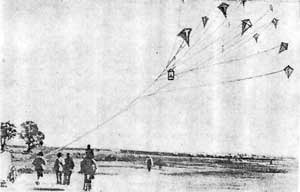|
Cluster Kite Systems Clusters of wings in one kite system form a cluster kite. Trains, stacks, trees, coteries, chains, segmented kite arches, rosaries, ... are cluster kite systems. We have dedicated folders for trains and stacks. And kite arches. And Rosary kites. In this folder we aim to face kite systems that structurally hint of trees, coteries, flowers, flocks, arrays, domes, meshes, nets, bushes, vines, bushes, spider webs, farm fields, and other special clusters is the mission of this folder. The nomenclature for kite clusters is still forming. Suggestions are ever invited. Just how to name certain types of clusters will be open for discussion. Categorizing any built-and-flown cluster should be a fun adventure. Having "smart" clusters is a challenge, but new tools will permit ever-smarter clusters to be flown. Passive traffic control of the wings in a cluster ever beckons the designer. Active traffic control of the wings in a cluster kite is a realm that may blossom because of advances in GPS, sensors, actuators, and control units. Why have various clusters? The challenge is there to fly clusters safely. Then the purpose of flying a cluster kite may range over the purposes found in kiting generally. We keep an eye for energy productions and works. Designing clusters that perform as wanted will prove to be a strong call on high-grade engineering. Building and rigging and flying clusters safely for various purposes will bring out the best talents in participants. Toy cluster kites? Sport cluster kites? Practical-tasked cluster kites? How might cluster kites fit into era K3? Into energy production systems? Teamwork; yes, teamwork! |
Single-point anchor:
More-than one anchor:
Separate anchors and separated wing sets, but with some kind of unified purpose of units:
Hybrids:
Free-flight cluster kites:
When the media is water:
|
Some teasing examples that are not trains or stacks
|
|
Discussion and scratching for cluster terms:
|
|
Resistance to cluster kite systems? While some clustering is
ancient and favored, there are challenges and resistances to cluster kite
systems. Recognizing resistances, complaints, disadvantages, and problems
may invite new solutions. We keep open to note the challenges. What have
you?
|
|
| Synergistic discovery paths: Plant world, graph theory, mathematics, sociology, matrix theory, nuclear theory, atomic theory, group theory, animal life, bird life, dust, seeds, kite history, aviation history, text types, classifications, classification theory, crystallography, chemistry, | |
| Some aspects: aggregate dynamics, repair, control, launching, landing, cluster thermodynamics, funding, simulating, modeling, line management, wing management, anchor management, energy management, risk management, weather coordination, safety, downing system. "Keep your distance, wing#329, or I'll bite you good!" Repulsion. Mixing. Coalescing. Swirling. Vibrating. Pulsing. Dancing. Pumping. | |
How shall we classify the concept of the carousel using spoked poles where
the poles are rooted from one hub or
 trunk?
Branches from main trunk? Branches having leaves? Is it a kind of flower
more than a tree? Flowers have pedals. But trees have branches and leaves
that fly ... that are kites. I am favoring "tree" for the KiteGen
carousel; a kite tree with main trunk, with branches, and with flying
leaves. The energy from the wind affects the leaves and branches and such
affects the trunk. The power take-off system (PTO) is at the trunk on the
proposed KiteGen carousel. Kite tree turbine generating
electricity! Examine the art and see what you come up with for
classification name in the cluster space. trunk?
Branches from main trunk? Branches having leaves? Is it a kind of flower
more than a tree? Flowers have pedals. But trees have branches and leaves
that fly ... that are kites. I am favoring "tree" for the KiteGen
carousel; a kite tree with main trunk, with branches, and with flying
leaves. The energy from the wind affects the leaves and branches and such
affects the trunk. The power take-off system (PTO) is at the trunk on the
proposed KiteGen carousel. Kite tree turbine generating
electricity! Examine the art and see what you come up with for
classification name in the cluster space. |
|
|
A
B
C
D
E
F
G
H
I
J
K
L
M
N
O
P
Q
R
S
T
U
V
W
X
Y
Z |
|
